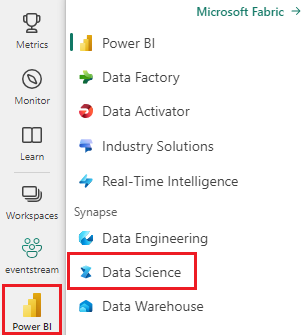Tutorial Part 1: Ingest data into a Microsoft Fabric lakehouse using Apache Spark
In this tutorial, you'll ingest data into Fabric lakehouses in delta lake format. Some important terms to understand:
Lakehouse - A lakehouse is a collection of files/folders/tables that represent a database over a data lake used by the Spark engine and SQL engine for big data processing and that includes enhanced capabilities for ACID transactions when using the open-source Delta formatted tables.
Delta Lake - Delta Lake is an open-source storage layer that brings ACID transactions, scalable metadata management, and batch and streaming data processing to Apache Spark. A Delta Lake table is a data table format that extends Parquet data files with a file-based transaction log for ACID transactions and scalable metadata management.
Azure Open Datasets are curated public datasets you can use to add scenario-specific features to machine learning solutions for more accurate models. Open Datasets are in the cloud on Microsoft Azure Storage and can be accessed by various methods including Apache Spark, REST API, Data factory, and other tools.
In this tutorial, you use the Apache Spark to:
- Read data from Azure Open Datasets containers.
- Write data into a Fabric lakehouse delta table.
Prerequisites
Get a Microsoft Fabric subscription. Or, sign up for a free Microsoft Fabric trial.
Sign in to Microsoft Fabric.
Use the experience switcher on the left side of your home page to switch to the Synapse Data Science experience.

- Add a lakehouse to this notebook. You'll be downloading data from a public blob, then storing the data in the lakehouse.
Follow along in notebook
1-ingest-data.ipynb is the notebook that accompanies this tutorial.
To open the accompanying notebook for this tutorial, follow the instructions in Prepare your system for data science tutorials, to import the notebook to your workspace.
If you'd rather copy and paste the code from this page, you can create a new notebook.
Be sure to attach a lakehouse to the notebook before you start running code.
Bank churn data
The dataset contains churn status of 10,000 customers. It also includes attributes that could impact churn such as:
- Credit score
- Geographical location (Germany, France, Spain)
- Gender (male, female)
- Age
- Tenure (years of being bank's customer)
- Account balance
- Estimated salary
- Number of products that a customer has purchased through the bank
- Credit card status (whether a customer has a credit card or not)
- Active member status (whether an active bank's customer or not)
The dataset also includes columns such as row number, customer ID, and customer surname that should have no impact on customer's decision to leave the bank.
The event that defines the customer's churn is the closing of the customer's bank account. The column exited in the dataset refers to customer's abandonment. There isn't much context available about these attributes so you have to proceed without having background information about the dataset. The aim is to understand how these attributes contribute to the exited status.
Example rows from the dataset:
| "CustomerID" | "Surname" | "CreditScore" | "Geography" | "Gender" | "Age" | "Tenure" | "Balance" | "NumOfProducts" | "HasCrCard" | "IsActiveMember" | "EstimatedSalary" | "Exited" |
|---|---|---|---|---|---|---|---|---|---|---|---|---|
| 15634602 | Hargrave | 619 | France | Female | 42 | 2 | 0.00 | 1 | 1 | 1 | 101348.88 | 1 |
| 15647311 | Hill | 608 | Spain | Female | 41 | 1 | 83807.86 | 1 | 0 | 1 | 112542.58 | 0 |
Download dataset and upload to lakehouse
Tip
By defining the following parameters, you can use this notebook with different datasets easily.
IS_CUSTOM_DATA = False # if TRUE, dataset has to be uploaded manually
DATA_ROOT = "/lakehouse/default"
DATA_FOLDER = "Files/churn" # folder with data files
DATA_FILE = "churn.csv" # data file name
This code downloads a publicly available version of the dataset and then stores it in a Fabric lakehouse.
Important
Make sure you add a lakehouse to the notebook before running it. Failure to do so will result in an error.
import os, requests
if not IS_CUSTOM_DATA:
# Download demo data files into lakehouse if not exist
remote_url = "https://synapseaisolutionsa.blob.core.windows.net/public/bankcustomerchurn"
file_list = [DATA_FILE]
download_path = f"{DATA_ROOT}/{DATA_FOLDER}/raw"
if not os.path.exists("/lakehouse/default"):
raise FileNotFoundError(
"Default lakehouse not found, please add a lakehouse and restart the session."
)
os.makedirs(download_path, exist_ok=True)
for fname in file_list:
if not os.path.exists(f"{download_path}/{fname}"):
r = requests.get(f"{remote_url}/{fname}", timeout=30)
with open(f"{download_path}/{fname}", "wb") as f:
f.write(r.content)
print("Downloaded demo data files into lakehouse.")
Related content
You'll use the data you just ingested in: